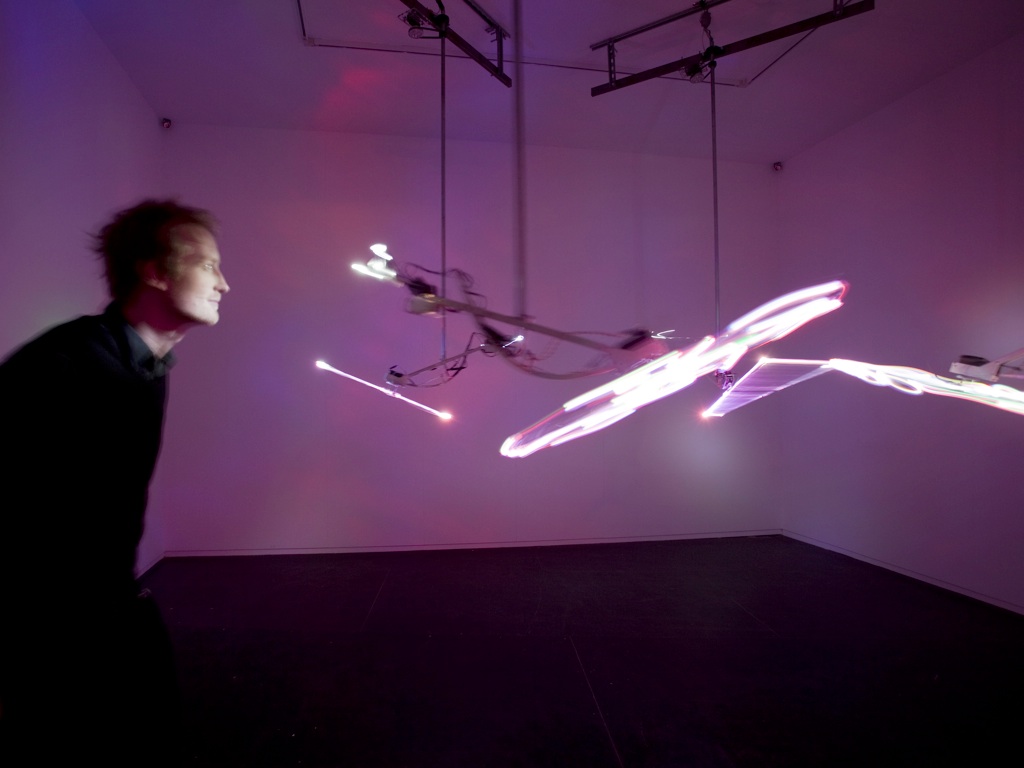UCL Bartlett Workshop: Lectures by Ruairi Glynn
‚ÄúWe will talk only about machines with very simple internal structures, too simple in fact to be interesting from the point of view of mechanical or electrical engineering. Interest arises, rather, when we look at these machines or vehicles as if they were animals, in a natural environment. We will be tempted, then, to use psychological language in describing their behavior. And yet we know very well that there is nothing in these vehicles that we have not put there ourselves…‚Äú
“…It is also quite easy to observe the full repertoire of behavior of these machines–even if it goes beyond what we had originally planned, as it often does. But it is much more difficult to start from the outside and try to guess internal structure just from observation of behavior. It is actually impossible in theory to determine exactly what the hidden mechanism is without opening the box, since there are always many different mechanisms with identical behavior…A psychological consequence of this is the following: when we analyze a mechanism we tend to over estimate its complexity.‚ÄĚ
Valentino Braitenberg, 1984, Vehicles: Experiments in Synthetic Psychology.
Learning from our natural environment
A strange animal like character is often the unintentional by-product of objects with the ability to sense, make¬†decisions and act on the world. We will celebrate this as a potentially powerful aesthetic and functional opportunity,¬†exploring the design of interactive architecture.¬†From the simplest bacteria, crustaceans, arachnids, plants and insects, right up to fish, birds, amphibians, reptiles and¬†mammals; from individual creatures to whole social communities, we will begin by investigating how the natural world¬†uses its ability to sense, think and act on the world. Consider the following examples: Birds of paradise mating rituals,¬†firefly‚Äôs synchronous light pulse dances, inter-continental whale songs, pheromone releasing ants, bioluminescent¬†Angler fish… There‚Äôs a lot of inspiration out there to extend our understanding of how intelligence, even very simple¬†intelligence can be both beautiful, functional and inspirational.¬†We will explore how our understanding of behaviour can inspire new design and research opportunities and the¬†creation of ecologies of intelligent environments that communicate and interact with each other and the world around¬†them. Think about how nature moves, Interacts, Attracts, Repels, Feeds, Fights, Hides, Adapts, Thinks, Mates, Cares,¬†Shows Emotion, and Plays.
Some insects demonstrate a simple type of learning that has been dubbed ‚Äúlearning by instinct‚ÄĚ.It is hypothesized that honey bees for example are pre-wired to learn how to. distinguish certain classes of flowers, and to learn routes to and from a home hive and sources of nectar. Other insects, butterflies, have been shown to be able to learn to distinguish flowers, but in an information limited way [8]. If they are forced to learn about a second sort of flower, they forget what they already knew about the first, in a manner that suggests the total amount of information which they know, remains constant.
Rodney Brooks, 1987, Intelligence without representation
Our Focus
While there’s a growing body of architectural research exploring formal biomimetic logics, little research has been given to the complex and intriguing adaptive behaviours the natural environment displays. Greater understanding could provide critical knowledge to the design of ecologically responsive and sustainable systems within the built environment as well as suggest new forms of engaging and personalised human-architecture interaction. We will explore these ideas though a Cybernetic framework and look at the sciences that came out of Cybernetics including Artificial Intelligence, Robotics and Computer Vision. In parallel we will look at the leading architects, artists and designers who are engaging with these technologies forming new hybrid art & science practices.
